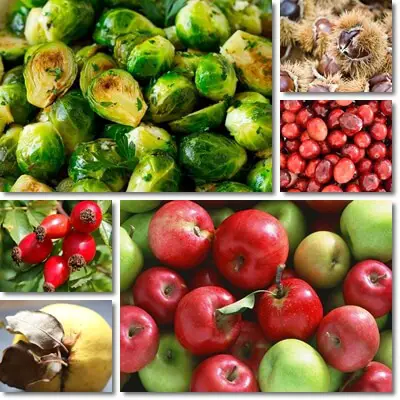What fruits and vegetables are in season in October? October is a rich month in terms of fruits and vegetables that come into season and thus the perfect time to start stocking up on everything from cranberries and rose hips to apples and quinces to last you all winter. Discover what are 9 of the best fruits and vegetables in season in October and what makes these seasonal foods good for you.
Chestnuts
Of all the foods in season in October, chestnuts are one of the best. Chestnuts are good for you because they are high in vitamin C (close to 50% of the recommended daily intake of vitamin C for an average adult per 100 g). Eating chestnuts raw gets you all of that vitamin C and subsequent benefits for teeth and gums as well as anti-inflammatory benefits. While roasting chestnuts cuts their vitamin C content in half, they’re still a great source of magnesium and potassium with benefits for high blood pressure, and a great source of vitamin B6 (over 25% of daily values) with benefits for skin, anemia and the nervous system.

Rose hips
Rose hips are the fruits of rose plants. While they don’t have the best taste, and they’re also hairy and full of seeds, rose hips are one of the best October fruits you can eat. For one, they are extremely high in vitamin C with an average of 300-400 mg of vitamin C per 100 g.
In addition to being good for gums and teeth, rose hips have antiviral, antibacterial and immune system modulating properties and give a serious boost to the immune system via their vitamin C content. High amounts of vitamin C have scientifically proven anti-inflammatory properties with benefits for inflammatory conditions such as arthritis, and antiproliferative and antitumor properties. You can also make rose hip tea from fresh or dried rose hips, an effective home remedy for high blood pressure.
Quinces
Quinces are a great October fruit. While they do make your mouth pucker and dry up if you eat them raw, quinces provide good amounts of vitamins C, B6, iron and potassium. Given their nutrition, quinces are good for high blood pressure, and provide anti-inflammatory benefits and benefits for muscle weakness, tiredness and fatigue. Boil, poach, stew or bake your quinces if you have gastritis, a stomach ulcer or simply a sour stomach. Cooked quinces are a light, soothing meal, good for gastrointestinal problems, helping calm stomach upset.
Cranberries
Cranberries are a good source of vitamins B5, B6, E and K, vitamin C if fresh, and high in the antioxidant manganese. Their deep red color is indicative of a high content of red pigmented antioxidants, primarily proanthocyanidins, and to a lesser extent, carotenoids. Research suggests cranberry juice helps reduce the frequency and length of urinary tract infections. If you experience frequent urinary tract infections, try drinking cranberry juice as prophylaxis. Cranberries also naturally have anti-bleeding properties, and their good manganese, vitamin E and C content is a source of anticancer benefits.

Apples
Apples are an emblematic October fruit. While overall not very nutritious, most people will eat them and do so happily. Apples are good for you because they are low in calories, a source of antioxidants and provide modest amounts of vitamin C and dietary fiber. Bake your apples with cinnamon and drizzle some raw honey on top after for a healthy dessert that’s also in season. Or pair with roasted almonds and raisins instead. For a full-on meal, core and stuff your apples with stir fried minced meat, chopped onions and peppers and grate Cheddar cheese on top, then bake until done. Eat your apples with skin for a boost in antioxidants and dietary fiber. Choose less acidic varieties if your have sensitive teeth, or cook the fruit.
Grapes
October is last-call for grapes. All colors are high in antioxidants, but black, blue, purple and red grapes are higher than white. Black, blue and purple grapes are loaded with dark anthocyanin antioxidants with scientifically proven anti-cancer properties. Red grapes are highest in proanthocyanidin antioxidants with free radical-scavenging properties and benefits for urinary tract infections. Grapes and fresh grape juice, aka must, help lower blood pressure and provide resveratrol and other bioactive components that promote cardiovascular health.
Brussels sprouts
As a cabbage family vegetable, Brussels sprouts are a source of organic sulfur compounds with scientifically proven anticancer properties. They are also extremely high in vitamin C, vitamin K and several B vitamins and dietary minerals such as iron, potassium, manganese and phosphorus. Take advantage of Brussels sprouts being in season in October to get all the benefits they have to offer. The small cabbages are good for anemia and its symptoms: tiredness, fatigue, weakness, apathy. Eating Brussels sprouts supports blood coagulation and is good for high blood pressure and bone density. Slice, stir fry, wrap in bacon or top with green onions and sour cream. You can also pair them with caramelized onions and carrots, and even apples.
Cabbage
Cabbage is in season in October and it’s one of the best vegetables to eat. Unlike Brussels sprouts which are bitter, cabbage is fresh, slightly peppery and faintly sweet, and can be eaten raw too. Cabbage is high in organic sulfur compounds with scientifically proven anticancer properties (glucosinolates such as sulforaphane, and Indole-3-carbinol). Both green and red cabbage owe their pigmentation to the same class of antioxidants: anthocyanins with anticancer properties.
Cabbage is high in vitamin B9 which is good for pregnant women and helps the baby develop normally during pregnancy, and vitamin B6 which has anti-anemia benefits. Eat cabbage raw to get lots of vitamin C for a boost in immunity. If you choose eat it cooked, simmer down the cabbage so you don’t lose minerals and water soluble vitamins in the cooking water.
Sweet potatoes
Sweet potatoes are in season right now and one of the best October vegetables to eat. The different colors provide different kinds of antioxidants with free radical scavenging properties (e.g. yellow and orange fleshed sweet potatoes are high in beta-carotene, while purple sweet potatoes are high in anthocyanins). Yellow and orange sweet potatoes have more nutritional value because their color is owed to alpha and beta-carotene antioxidants which have vitamin A activity. Pair your sweet potatoes with butter to boost your absorption of pro-vitamin A antioxidants for benefits for eyesight, skin and the immune system. Also high in vitamins B5, B6 and a good source of iron, sweet potatoes help combat anemia-associated fatigue and muscle weakness, while magnesium and potassium in the October vegetable help lower high blood pressure numbers.
